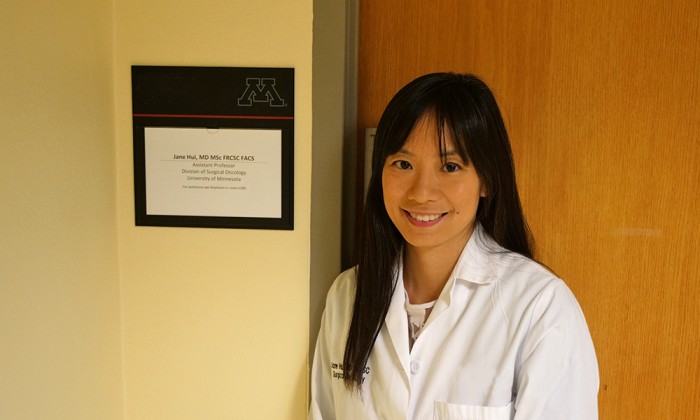
Jane Hui, MD, is a University of Minnesota Physicians Surgical Oncologist and Assistant Professor with the Department of Surgery for the University of Minnesota Medical School. A surgical oncologist is a surgeon who has undergone additional, specific training to care for and operate on cancer patients.
Breast cancer is the most commonly diagnosed cancer in women. It is largely not preventable, but better outcomes can be achieved with early detection. Since October is Breast Cancer Awareness Month, Dr. Hui detailed common questions and topics of interest regarding the issue.
What are some risk factors for breast cancer?
In most cases, we cannot pinpoint a single reason as the cause for someone’s breast cancer, but certain factors make it more likely for someone to get breast cancer. Family history and inherited genetic mutations (for example, BRCA1 or BRCA2) are some of the strongest risk factors. If you do have a family history of breast cancer, we recommend speaking with your doctor to see if you need to start screening earlier than age 40. It is also important to remember that having any risk factors does not necessarily mean you will get breast cancer. Finally, getting regular screening mammograms is important, not to reduce your risk of breast cancer, but to detect abnormalities as early as possible.
What can I do to reduce my risk of breast cancer?
There are modifiable risk factors, such as the use of hormone replacement therapy after menopause, being overweight or obese and alcohol use. This means that certain lifestyle adjustments can be made to lower risk from these factors. Balancing a healthy diet with regular physical activity and exercise to limit excessive weight gain and limiting alcohol intake are great ways to not only reduce your risk of breast cancer but also to improve your overall health.
Why is early detection of breast cancer so important?
Treating breast cancer earlier allows for more options when it comes to treatment and, most importantly, leads to better outcomes. A yearly screening mammogram is recommended for average-risk women over the age of 40. This applies to women without family or personal history of breast cancer. A screening mammogram means we are taking images of the breast even when a patient does not have any signs or symptoms; this allows us to identify breast abnormalities in its very early stages, when they are very small and undetectable by physical exam or by the patient.
What are the signs and symptoms of breast cancer?
Signs of breast cancer include:
- A mass in the breast and/or axilla (armpit)
- Non-milky nipple discharge (fluid from the nipple)
- Redness/scabbing/opening in the nipple
- Redness/thickening of the skin of the breast
- Dimpling in the skin of the breast
- New pulling-in of the nipple
- Overall change in the shape or size of the breast
What’s unique about breast cancer?
Fortunately, breast cancer is one of the few cancers that can be detected early by easy-to-obtain screening tests that are available widely to the public (a mammogram). It is also one of the few types of cancers that is affected by hormone (estrogen) levels. Some types of breast cancers aren’t treated with chemotherapy, but rather with hormone blockers. Chemotherapy and hormone blockers can be used in conjunction or separately based on each individual’s treatment plan.